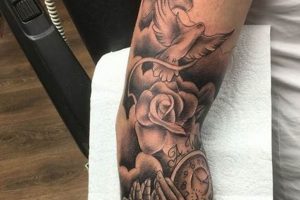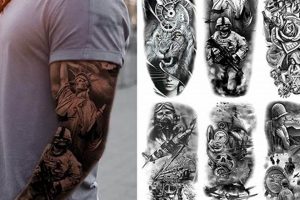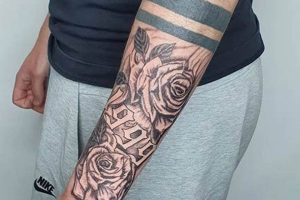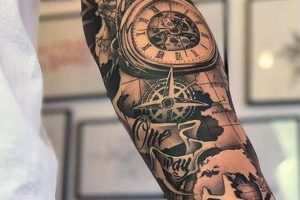Full arm tattoo designs, often referred to as sleeves, offer a large canvas for artistic expression. They provide the opportunity to create a cohesive and impactful visual narrative, incorporating various elements like imagery, symbolism, and stylistic choices. A sleeve might feature a nature theme with intertwining flowers and animals, a portrait of a loved one rendered in realistic detail, or an abstract design using geometric shapes and bold colors.
The enduring popularity of sleeve tattoos stems from their ability to showcase a significant commitment to body art. These extensive designs can represent deeply personal stories, beliefs, or passions. Historically, full arm tattoos have been associated with various cultures and traditions, signifying status, group affiliation, or spiritual beliefs. Today, they continue to be a powerful form of self-expression and a testament to the artistry of tattooing. A well-executed sleeve tattoo can be a stunning piece of art that evolves with the individual over time.
Exploring the diverse options available for sleeve tattoos requires careful consideration of various factors, including theme, style, placement, and artist selection. Understanding these elements is essential for creating a design that is both visually appealing and personally meaningful.
Tips for Planning Extensive Arm Tattoos
Careful planning is crucial for successful full arm tattoo designs. These tips offer guidance for navigating the process effectively.
Tip 1: Theme Selection: Choosing a unifying theme helps create a cohesive narrative. Consider themes like nature, mythology, or personal experiences to tie the elements together.
Tip 2: Research and Style Exploration: Explore various tattoo styles, such as realism, traditional, or Japanese, to find one that aligns with the chosen theme and personal aesthetic.
Tip 3: Artist Selection: Research reputable tattoo artists specializing in the preferred style. Review portfolios and seek consultations to ensure artistic compatibility.
Tip 4: Budget Considerations: Large-scale tattoos require significant financial investment. Establish a realistic budget early in the planning process.
Tip 5: Placement and Flow: Consider how the design will flow around the natural contours of the arm. Discuss placement options with the chosen artist for optimal visual impact.
Tip 6: Pain Management: Arm tattoos, especially those covering large areas, can be painful. Prepare for multiple sessions and discuss pain management techniques with the artist.
Tip 7: Aftercare Commitment: Proper aftercare is essential for healing and preserving the vibrancy of the tattoo. Follow the artist’s instructions diligently.
By following these guidelines, individuals can embark on the journey of creating a meaningful and visually stunning arm tattoo.
These preparatory steps ensure a successful and fulfilling tattoo experience, resulting in a piece of art that will be cherished for years to come.
1. Theme
A cohesive theme is paramount for successful full arm tattoo designs. It provides a unifying narrative, linking individual elements into a harmonious whole and transforming a collection of disparate images into a powerful, storytelling piece of art. Theme selection should precede other design considerations, serving as the conceptual foundation upon which the entire sleeve is built.
- Nature
Nature-inspired themes offer vast possibilities, from intricate floral designs to majestic animal portraits. Examples include a sleeve depicting a forest scene transitioning from day to night, or an underwater seascape teeming with marine life. Such themes often symbolize growth, interconnectedness, and the power of the natural world.
- Mythology and Folklore
Drawing inspiration from ancient myths and legends provides a rich source of imagery and symbolism. Norse gods, Greek heroes, or Japanese yokai can be interwoven to create compelling narratives. These themes often explore universal human experiences, like love, loss, and the struggle between good and evil.
- Abstract and Geometric
Abstract and geometric designs offer a modern and visually striking approach. Utilizing shapes, lines, and patterns, these themes can evoke emotions and concepts through visual language. Examples include intricate mandalas, sacred geometry, or dynamic op-art inspired patterns. These themes often represent balance, order, and the exploration of abstract concepts.
- Personal Narrative
Sleeve tattoos can serve as powerful autobiographical statements. Incorporating elements representing significant life events, hobbies, or personal beliefs allows for a deeply personal and meaningful design. This approach transforms the body into a living canvas, telling a unique and evolving story.
The chosen theme serves as the guiding principle for all subsequent design choices, impacting style, color palette, and overall composition. Careful consideration of thematic resonance ensures a cohesive and impactful sleeve tattoo that reflects individual values and aesthetic preferences.
2. Style
Style significantly influences the aesthetic impact of sleeve tattoos. Selecting a style that resonates with personal preferences and complements the chosen theme is essential for creating a cohesive and visually appealing design. Different styles evoke distinct moods and convey varying levels of detail and symbolism. Understanding the nuances of each style allows for informed decisions and ensures a harmonious fusion of artistic vision and personal expression.
- Realism
Realism focuses on replicating real-life imagery with meticulous detail and accuracy. Portraits, landscapes, or objects are rendered with lifelike precision, often incorporating shading and highlights to create a three-dimensional effect. This style demands a high level of technical skill from the artist and can be particularly effective for showcasing specific subjects or paying homage to loved ones.
- Traditional
Traditional tattooing, also known as American Traditional or Old School, features bold lines, vibrant colors, and iconic imagery. Common motifs include anchors, roses, eagles, and nautical stars. This style has a rich history and distinct visual appeal, often conveying a sense of timelessness and classic elegance.
- Japanese
Japanese tattooing, or Irezumi, is characterized by its bold outlines, vibrant colors, and intricate details. Themes often draw from Japanese folklore, mythology, and nature, featuring imagery such as dragons, koi fish, and samurai. This style is deeply rooted in tradition and symbolism, often carrying specific cultural meanings.
- Neo-Traditional
Neo-Traditional takes inspiration from Traditional tattooing while incorporating modern elements and a wider range of subject matter. It retains the bold lines and bright colors but often features more detailed shading and a broader palette. This style allows for greater artistic freedom and can be used to create unique and contemporary interpretations of classic imagery.
The chosen style acts as a visual filter through which the thematic narrative is presented. Careful consideration of style ensures that the final design not only reflects personal aesthetic preferences but also effectively communicates the intended message. Harmonizing style and theme creates a powerful visual symphony, transforming the arm into a captivating canvas of personal expression.
3. Placement
Placement is a critical factor in sleeve tattoo design, influencing both the aesthetic impact and the narrative flow. The arm’s natural contours and musculature present both opportunities and challenges for design placement. Strategic consideration of how the design interacts with the body’s form is essential for creating a visually harmonious and impactful piece of art. Placement choices can emphasize or diminish certain design elements, impacting the overall composition and storytelling potential.
- Inner Arm
The inner arm offers a relatively flat and less visible canvas, suitable for designs that are more personal or intended for a select audience. This placement is often favored for script, smaller designs, or elements that contribute to the overall narrative but are not meant to be the primary focal point. Due to its sensitivity, the inner arm can be a more challenging area for tattooing.
- Outer Arm
The outer arm provides a prominent display area, ideal for bold designs and key thematic elements. Its visibility makes it suitable for showcasing intricate details and impactful imagery. This placement is often favored for larger motifs, vibrant colors, and designs intended to make a strong visual statement.
- Shoulder and Bicep
The shoulder and bicep offer a dynamic canvas that interacts with muscle movement. Designs placed here can appear to flex and flow with the body, creating a sense of animation and energy. This placement is often used for larger, more prominent elements that anchor the overall design or serve as visual centerpieces.
- Forearm and Wrist
The forearm and wrist provide a versatile canvas for both smaller, independent designs and extensions of larger compositions. These areas are often used for detailed elements, symbolic imagery, or text that adds narrative depth. The visibility of these placements allows for frequent viewing and personal reflection.
Effective placement harmonizes the design with the body’s natural architecture. It guides the viewer’s eye, emphasizing key elements and creating a cohesive visual narrative. Thoughtful placement choices elevate the design, transforming the arm into a dynamic and expressive canvas that showcases both artistic skill and personal significance.
4. Color Palette
Color palettes play a crucial role in sleeve tattoo design, influencing the overall mood, visual impact, and symbolic meaning. Careful color selection harmonizes with the chosen theme and style, enhancing the narrative and creating a cohesive aesthetic. Color palettes can evoke a wide range of emotions, from serenity and tranquility to vibrancy and energy. Understanding the interplay of colors and their cultural associations is essential for creating a meaningful and visually compelling sleeve tattoo.
- Black and Gray
Black and gray palettes offer a timeless and versatile approach, suitable for a variety of themes and styles. This classic combination creates a sense of depth and dimension, allowing for intricate details and subtle shading. Black and gray are often used in realism and portraiture, but can also be effective in other styles like traditional or Japanese.
- Vibrant and Bold
Vibrant color palettes inject energy and dynamism into sleeve designs. Bold hues like red, yellow, and blue can create a striking visual impact, drawing attention to key elements and conveying a sense of excitement and passion. These palettes are often seen in traditional, neo-traditional, and illustrative styles.
- Muted and Pastel
Muted and pastel palettes offer a softer and more delicate aesthetic. These subtle hues create a sense of tranquility and serenity, often associated with themes of nature, spirituality, or personal reflection. Pastel palettes can be particularly effective in watercolor or illustrative styles.
- Monochromatic
Monochromatic palettes utilize variations of a single color, creating a harmonious and unified look. This approach can be used to emphasize specific themes or evoke particular emotions. For example, a monochromatic blue palette might represent tranquility and depth, while a monochromatic red palette could convey passion and intensity. Monochromatic palettes can be adapted to various styles, offering a unique and cohesive aesthetic.
The chosen color palette significantly impacts the overall aesthetic and emotional impact of a sleeve tattoo. Harmonizing color choices with the chosen theme, style, and personal meaning creates a powerful visual narrative. A well-chosen color palette elevates the design, transforming the arm into a captivating canvas that resonates with both the wearer and the observer.
5. Artist Skill
Artist skill is paramount in realizing complex and extensive tattoo designs like sleeves. A skilled artist possesses technical proficiency, artistic vision, and the ability to translate concepts into visually compelling realities. Technical proficiency encompasses needle control, ink saturation, and understanding skin variations. This mastery ensures clean lines, smooth shading, and vibrant color saturation, crucial for a high-quality, long-lasting tattoo. Artistic vision encompasses composition, flow, and understanding how the design interacts with the body’s contours. A skilled artist considers the arm’s three-dimensionality, ensuring the design complements its natural form and creates a dynamic, visually appealing result, rather than appearing flat or distorted. The ability to translate concepts into reality requires effective communication and interpretive skills. A skilled artist listens to client ideas, offering expert guidance and transforming abstract concepts into tangible designs. This collaborative process ensures the final tattoo reflects the client’s vision while benefiting from the artist’s expertise. For example, a client might envision a sleeve featuring a Japanese dragon. A skilled artist translates this concept into a dynamic design, incorporating traditional elements, appropriate color palettes, and a composition that flows seamlessly with the arm’s musculature.
The impact of artist skill extends beyond technical execution. A skilled artist understands the importance of hygiene and safety, employing sterile techniques and adhering to best practices to minimize risks. They also possess knowledge of different skin types and their reactions to tattooing, allowing them to adapt techniques and ensure optimal healing. Furthermore, experienced artists provide valuable guidance on aftercare, ensuring the longevity and vibrancy of the tattoo. Conversely, inadequate artist skill can result in uneven lines, blown-out colors, and poorly executed designs. This not only compromises the aesthetic appeal but can also lead to complications during healing. Choosing an artist based solely on price or convenience can have detrimental consequences, highlighting the importance of prioritizing skill and experience.
Ultimately, artist skill is the cornerstone of successful sleeve tattooing. It ensures the seamless fusion of technical proficiency, artistic vision, and client collaboration. Investing time in researching and selecting a skilled artist is crucial for realizing the full potential of the design and ensuring a high-quality, enduring piece of body art. This informed decision transforms a tattoo concept into a powerful expression of personal identity, showcasing both the client’s vision and the artist’s mastery.
6. Personal Meaning
Sleeve tattoos, given their prominent placement and scale, often carry deep personal significance. They offer a unique canvas for expressing individuality, commemorating experiences, and reflecting personal values. The process of imbuing a sleeve tattoo with personal meaning transforms it from mere body art into a powerful statement of self. This exploration delves into the multifaceted relationship between personal meaning and sleeve tattoo designs.
- Life Experiences
Life experiences, both positive and challenging, can be powerfully represented through sleeve tattoos. A symbolic image representing overcoming a difficult period, a portrait commemorating a loved one, or imagery reflecting a significant journey can serve as a permanent reminder of personal growth and resilience. For example, a phoenix rising from flames could symbolize overcoming adversity, while a compass could represent a journey of self-discovery. These visual narratives etched onto the skin serve as constant sources of inspiration and reflection.
- Values and Beliefs
Sleeve tattoos can serve as visual expressions of deeply held values and beliefs. Whether it’s a spiritual symbol, a quote representing a personal philosophy, or imagery reflecting a commitment to a cause, these designs communicate core values to the world. A depiction of a deity could represent spiritual devotion, while a geometric pattern could symbolize a belief in order and balance. These visual declarations affirm personal identity and create a sense of connection with like-minded individuals.
- Passions and Hobbies
Incorporating passions and hobbies into sleeve tattoo designs allows individuals to showcase their interests and celebrate what brings them joy. Whether it’s a musical instrument, a favorite character from literature, or imagery related to a beloved sport, these designs reflect a vibrant and multifaceted personality. A sleeve depicting musical notes could represent a passion for music, while a tattoo of a literary quote could showcase a love of reading. These visual representations spark conversation and offer glimpses into the wearer’s unique interests.
- Cultural Heritage
Sleeve tattoos can be a powerful way to honor and celebrate one’s cultural heritage. Incorporating traditional patterns, symbols, or imagery from one’s ancestry creates a visual link to the past and affirms a sense of belonging. For example, incorporating Maori T moko designs could represent a connection to New Zealand heritage, while Celtic knotwork could symbolize Irish or Scottish roots. These designs serve as a visible tribute to one’s ancestry and contribute to the preservation of cultural traditions.
Ultimately, personal meaning is the heart and soul of a truly impactful sleeve tattoo. It transforms a collection of images into a deeply personal narrative, reflecting the wearer’s unique journey, values, and identity. By infusing these extensive designs with personal significance, individuals create powerful and enduring works of art that resonate with both themselves and the world around them. This integration of personal meaning elevates the sleeve tattoo beyond mere aesthetics, transforming it into a powerful symbol of self-expression and a testament to the enduring power of the human story.
7. Long-Term Commitment
Sleeve tattoos represent a significant commitment due to their scale, visibility, and permanence. Careful consideration of the long-term implications is crucial before embarking on such an extensive project. This involves not only selecting a design that resonates deeply but also acknowledging the practical and social considerations that accompany a lifelong piece of body art.
- Permanence and Removal
Tattoo removal is a time-consuming, costly, and often incomplete process. While advancements in laser technology have improved removal outcomes, complete removal is not always guaranteed, and some scarring or skin discoloration may occur. Therefore, sleeve tattoos should be approached with the understanding that they are intended to be permanent. This underscores the importance of careful planning and thoughtful design selection, ensuring the chosen imagery and symbolism will resonate for years to come. Impulsive decisions can lead to later regret, highlighting the need for thorough consideration before committing to a large-scale, permanent design.
- Professional Implications
While societal acceptance of tattoos has increased, certain professions may still maintain dress codes or policies that restrict visible tattoos. Sleeve tattoos, due to their prominence, may limit career options in some fields. Considering potential career paths and researching industry-specific tattoo policies is essential before committing to a sleeve design. This proactive approach allows individuals to make informed decisions that align with both personal expression and professional goals. Understanding the potential impact on career prospects ensures that the decision to get a sleeve tattoo is made with full awareness of its potential professional implications.
- Social Perceptions
While societal views on tattoos are evolving, individual reactions can vary. Sleeve tattoos, due to their visibility, may attract attention and elicit diverse responses, ranging from admiration to judgment. Developing a thick skin and being prepared to address questions or comments about the tattoo is important. This awareness allows individuals to navigate social situations with confidence and comfort. Acceptance of potential scrutiny ensures that the decision to get a sleeve tattoo is made with a realistic understanding of its social impact.
- Lifestyle Considerations
The healing process for a sleeve tattoo requires significant time and diligent aftercare. Sun exposure, certain activities, and clothing choices may need to be adjusted during and after the healing period to protect the tattoo and ensure optimal color retention. Furthermore, maintaining the vibrancy of a sleeve tattoo over time may require touch-ups and ongoing care. This long-term commitment to aftercare and maintenance is a crucial aspect of preserving the integrity and aesthetic appeal of the design. Understanding these requirements ensures individuals are prepared for the ongoing responsibility that accompanies a large-scale tattoo.
Considering these long-term commitments underscores the importance of viewing sleeve tattoos as significant life decisions. Careful planning, thoughtful design selection, and a realistic understanding of the practical and social implications ensure that the final result is a source of personal pride and satisfaction for years to come. This informed approach transforms the process from a fleeting impulse into a meaningful act of self-expression, reflecting a deep understanding of the enduring power and responsibility that accompanies a lifelong commitment to body art.
Frequently Asked Questions
Addressing common inquiries regarding extensive arm tattoos provides clarity and facilitates informed decision-making. The following addresses prevalent concerns and misconceptions.
Question 1: What is the typical cost of a full sleeve tattoo?
The cost varies significantly based on artist experience, geographic location, design complexity, and session duration. Several thousand dollars should be budgeted for a high-quality, full sleeve tattoo by a reputable artist.
Question 2: How long does a full sleeve tattoo take to complete?
Completion time depends on design intricacy, individual pain tolerance, and session scheduling. A full sleeve typically requires multiple sessions, potentially spanning several months or even a year.
Question 3: How painful is getting a sleeve tattoo?
Pain levels vary depending on individual pain thresholds and the specific location on the arm. Inner arm areas tend to be more sensitive. Discussing pain management options with the artist can alleviate discomfort during the process.
Question 4: What is the best aftercare regimen for a sleeve tattoo?
Following the artist’s specific aftercare instructions is crucial for proper healing. General guidelines include keeping the tattoo clean, moisturized, and protected from sun exposure. Avoiding tight clothing and submerging the tattoo in water during the initial healing phase is also recommended.
Question 5: Can I cover up an existing tattoo with a sleeve?
Cover-up possibilities depend on the size, color, and location of the existing tattoo. Consulting with a skilled artist experienced in cover-ups is essential to determine feasibility and discuss design options.
Question 6: What factors should I consider when choosing a tattoo artist for a sleeve?
Artist selection is crucial for a successful sleeve tattoo. Researching portfolios, reviewing client testimonials, and scheduling consultations with potential artists are essential steps. Evaluating artistic style, experience, hygiene practices, and communication skills ensures compatibility and a positive tattooing experience.
Thorough consideration of these frequently asked questions empowers individuals to approach the process of getting a sleeve tattoo with realistic expectations and informed decision-making. This preparation contributes to a positive experience and a final result that aligns with personal vision and aesthetic preferences.
Further exploration of specific design elements and artistic styles can provide additional inspiration and guidance for those considering a full arm tattoo.
Conclusion
Extensive arm tattoo designs offer a powerful canvas for self-expression, allowing individuals to showcase intricate narratives, deeply held values, and personal aesthetics. Careful consideration of thematic cohesion, stylistic choices, placement strategies, and color palettes is essential for creating a visually compelling and personally meaningful piece of art. Artist skill and experience are paramount, ensuring technical proficiency and artistic interpretation align seamlessly with individual visions. Recognizing the permanence and social implications of sleeve tattoos underscores the importance of thoughtful planning and long-term commitment.
Ultimately, embarking on the sleeve tattoo journey requires introspection, research, and a deep understanding of the transformative power of body art. This permanent commitment reflects not only an aesthetic choice but a profound expression of personal identity, evolving with the individual over time and serving as a testament to the enduring human capacity for storytelling and self-discovery.







